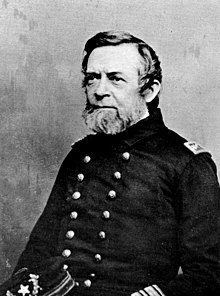Andrew Hull Foote
Andrew Hull Foote (born September 12, 1806 in New Haven , Connecticut , † June 26, 1863 in New York City ) was a rear admiral in the United States Navy who served during the American Civil War.
He was born in New Haven , Connecticut . His father was the US Senator Samuel A. Foot (also Foote). Foote went to the US Military Academy at West Point in 1826 . Half a year later, however, he decided to pursue a career in the US Navy. Between 1822 and 1843, Foote served in the Caribbean , Pacific , Mediterranean, and at the Philadelphia Navy Yard .
Between 1849 and 1851 Foote commanded the USS Perry , which patrolled the coast of Africa and whose aim was to prevent the slave trade. This personal experience made him a proponent of the liberation of slaves . He became a well-known advocate for the anti-slavery movement . From 1851 to 1856 Foote served in various posts on land, including the US Navy Effenciecy Board , founded by Commodore Samuel Francis Du Pont .
Foote was promoted to Commander in 1856 and commanded the USS Portsmouth in the East India Squadron (East India Squadron). Foote was tasked with monitoring British operations against Canton during the Second Opium War , but this resulted in him being attacked by Chinese coastal batteries. Foote then ordered a retaliatory operation against the defensive forts of the Chinese. In 1858 he returned to the United States and commanded the Brooklyn Navy Yard in New York. He held this post until the outbreak of the American Civil War .
From August 30, 1861 to May 9, 1862, Foote commanded the Mississippi River Squadron with honors. He organized and directed the conquest of forts Henry, Donelson and "Island Number 10". He received thanks from Congress for his actions in these three battles . Foote was wounded in the fighting for Fort Denelson. He was promoted to Rear Admiral on July 16, 1862 and was on his way to his new command, the South Atlantic Blockading Squadron, when he died on June 26, 1863 in New York.
Three ships were named USS Foote after him , including the destroyer USS Foote (DD-511) , which entered service in 1946 . He was also the namesake for a civil war fort on the Potomac River , now a national park.
Web links
- Biography (English)
- Andrew Hull Foote in the database of Find a Grave (English)
| personal data | |
|---|---|
| SURNAME | Foote, Andrew Hull |
| BRIEF DESCRIPTION | Rear Admiral of the United States Navy during the American Civil War |
| DATE OF BIRTH | September 12, 1806 |
| PLACE OF BIRTH | New Haven , Connecticut |
| DATE OF DEATH | June 26, 1863 |
| Place of death | New York City |
